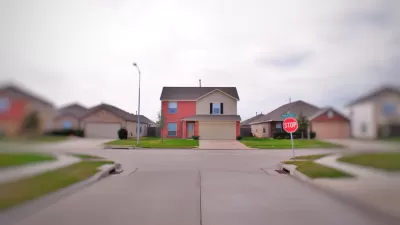Beware of possible code words like "character" and "flavor" when it comes to community resistance to multifamily housing or increased density. Case in point, Garden City, Long Island.

Using what the appeals court called code words, residents said that multifamily housing would change the “flavor” and “character” of the village and would lead to “four or 10 people in an apartment,” and demanded a guarantee that the housing be “upscale."
Background
The zoning change was enacted in response to outcries from residents at public hearings about the development of multifamily housing on a 25-acre lot sold to the village by Nassau County, "with some speakers warning that lower-income tenants would be drawn to more affordable apartments," wrote The New York Times neighborhood reporter, Joseph Berger in a Dec. 6, 2013 article.
"The Village enacted zoning that allowed townhouses (R-T zoning) instead of multifamily housing (R-M zoning), which it had earlier considered," according to the Garden City News. "The plaintiff claimed that by not allowing multifamily housing the village discriminated against minorities."
The district court rendered a decision that sided with Mutual Housing Association of New York (MHANY Management) and the Long Island chapter of New York Communities for Change, the groups which took up the case after ACORN was dissolved in 2010. Berger wrote:
Judge Arthur D. Spatt of Federal District Court in Central Islip, N.Y., concluded that “the plaintiffs have established by a preponderance of evidence” that “the village’s acts had both an adverse impact on minorities and tended to perpetuate segregation.” Less discriminatory alternatives for zoning could have been found, the judge said. He gave the plaintiffs 30 days to propose remedies that the village should take.
Instead of remedies, the village appealed, and lost their case on March 23.
Today
"'Something was amiss here,' a three-judge panel of the United States Court of Appeals for the Second Circuit wrote in its decision," writes Foderaro. "Garden City’s abrupt shift in zoning in the face of vocal opposition to changing the character of Garden City represented acquiescence to race-based animus." [A condition more widespread than we may want to acknowledge.]
“It’s another signal that the tide is turning in terms of fair housing,” said Prof. Robert M. Silverman, of the School of Architecture and Planning at the State University of New York at Buffalo, who has written extensively on the subject of housing segregation. “There’s a historic pattern of segregation that those places have experienced.”
Ironically, the 25-acre lot in Garden City has been rezoned for a courthouse, but the appeals judges directed "the district court to determine whether officials in Nassau County, had deliberately steered affordable housing to low-income areas with largely minority populations," such as Garden City's neighbor, Hempstead, "where nearly half the residents are African-American," notes Foderaro. By comparison, 1.2 percent of Garden City's population was African American in 2010. [See New York Times, 2002: "Study Calls L.I. Most Segregated Suburb."].
Foderaro points to other communities where the courts have cracked down on similar cases of housing segregation done by exclusionary zoning, including "Marin County, Calif., Westchester County, N.Y.; and the city of Dallas. She goes on to describe Westchester's case, and what's ahead for Garden City.
Planetizen looked at a similar cases in Pleasanton, in Alameda County in the San Francisco Bay Area, though that case dealt with state housing law and regional planning, as well as the landmark Mount Laurel, N.J. decisions. Last June, the Supreme Court ruled on the concept of "disparate impact" resulting from housing discrimination in affluent communities outside Dallas.
What ties all these cases together is the importance of nonprofit housing or social justice groups taking to the courts to address local housing discrimination caused by exclusionary zoning.
FULL STORY: Housing Bias Outlasts Ruling in a Long Island Village

Planetizen Federal Action Tracker
A weekly monitor of how Trump’s orders and actions are impacting planners and planning in America.

DARTSpace Platform Streamlines Dallas TOD Application Process
The Dallas transit agency hopes a shorter permitting timeline will boost transit-oriented development around rail stations.

Congressman Proposes Bill to Rename DC Metro “Trump Train”
The Make Autorail Great Again Act would withhold federal funding to the system until the Washington Metropolitan Area Transit Authority (WMATA), rebrands as the Washington Metropolitan Authority for Greater Access (WMAGA).

Supreme Court Ruling in Pipeline Case Guts Federal Environmental Law
The decision limits the scope of a federal law that mandates extensive environmental impact reviews of energy, infrastructure, and transportation projects.

Texas State Bills to Defund Dallas Transit Die
DART would have seen a 30% service cut, $230M annual losses had the bills survived.

Bikeshare for the Win: Team Pedals to London Cricket Match, Beats Rivals Stuck in Traffic
While their opponents sat in gridlock, England's national cricket team hopped Lime bikes, riding to a 3-0 victory.
Urban Design for Planners 1: Software Tools
This six-course series explores essential urban design concepts using open source software and equips planners with the tools they need to participate fully in the urban design process.
Planning for Universal Design
Learn the tools for implementing Universal Design in planning regulations.
Roanoke Valley-Alleghany Regional Commission
City of Mt Shasta
City of Camden Redevelopment Agency
City of Astoria
Transportation Research & Education Center (TREC) at Portland State University
US High Speed Rail Association
City of Camden Redevelopment Agency
Municipality of Princeton (NJ)





























